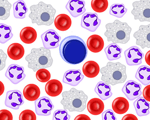 NRx (formerly known as Net Results Express) is UHN's monthly research e-newsletter. Through NRx you can read about ongoing research at our five research institutes, the Ontario Cancer Institute (OCI), the Toronto General Research Institute (TGRI), the Toronto Western Research Institute (TWRI), the Toronto Rehabilitation Institute (TRI) and the Techna Institute (Techna).
NRx (formerly known as Net Results Express) is UHN's monthly research e-newsletter. Through NRx you can read about ongoing research at our five research institutes, the Ontario Cancer Institute (OCI), the Toronto General Research Institute (TGRI), the Toronto Western Research Institute (TWRI), the Toronto Rehabilitation Institute (TRI) and the Techna Institute (Techna).
In this issue you can read about research in:
- How the brain controls blood sugar levels in diabetes
- Proteins that regulate the development of blood cells
- The predictive value of KRAS mutations in lung cancer
- A new experimental model for Farber disease
- Effective therapies for reducing joint damage in psoriatic arthritis
- Swallowing and speech impairments after stroke
We hope that you will find NRx informative and helpful. If you have feedback or questions, please contact www@uhnresearch.ca.
Christopher J. Paige, PhD, FCAHS
Vice President, Research
University Health Network

Glucagon is currently used as an emergency treatment of severe diabetic hypoglycemia, which is associated with low blood glucose levels.
Glucagon is an important protein for the control of blood sugar levels. Normally, glucagon stimulates a temporary increase in blood sugar levels and then a decrease to normal levels. However, in diabetes and obesity, this response is impaired and blood sugar levels do not decrease. TGRI Senior Scientist Dr. Tony Lam has discovered that glucagon regulates the increase and subsequent decrease in blood sugar through actions in the hypothalamus, the region of the brain responsible for regulating sugar production by the liver. A signalling mechanism in the hypothalamus, known as the protein kinase A (PKA) pathway, was responsible for mediating glucagon's control over blood sugar levels.
Dr. Lam's group examined experimental models of diabetes and obesity and observed that the hypothalamus improperly responded to glucagon by only increasing blood sugar, a characteristic of these conditions. However, when the PKA pathway was directly activated, blood sugar levels decreased to normal, suggesting that the hypothalamus develops a resistance to glucagon in diabetes and obesity. "These findings also indicate that drugs that target glucagon action in the brain could regulate sugar levels in diabetes," says Dr. Lam.
This work was supported by the Canadian Diabetes Association. Dr. Lam holds the John Kitson McIvor Endowed Chair in Diabetes Research and is a Tier 2 Canada Research Chair in Obesity.
Hypothalamic glucagon signaling inhibits hepatic glucose production. Mighiu PI, Yue JT, Filippi BM, Abraham MA, Chari M, Lam CK, Yang CS, Christian NR, Charron MJ, Lam TK. Nature Medicine. 2013 May 19. [Pubmed abstract]

HSCs (blue) can develop into different cell types including neutrophils (purple), macrophages (grey) and red blood cells (red).
It is well established that all blood cells develop from a specialized cell known as a hematopoietic stem cell (HSC); however, researchers don’t fully understand the intricate mechanisms that regulate this process. A breakthrough study from OCI Senior Scientist and McEwen Centre for Regenerative Medicine Director Dr. Gordon Keller and collaborators has identified a protein known as Sox17 that plays a key role in regulating the development of blood cells. The study revealed that Sox17 is essential for HSC development and critical for expansion of HSCs into T cells, a specific type of cell that is crucial to a healthy immune system. Explains Dr. Keller, "Deciphering the regulatory pathways that control how blood cells develop is essential to generating these cells in the lab. These studies will be the foundation upon which we can begin to develop stem cell based therapies for blood cell disorders."
This work was supported by the Canadian Institutes of Health Research and the US National Institutes of Health.
The expression of Sox17 identifies and regulates haemogenic endothelium. Clarke RL, Yzaguirre AD, Yashiro-Ohtani Y, Bondue A, Blanpain C, Pear WS, Speck NA, Keller G. Nature Cell Biology. 2013 April 21. [Pubmed abstract]

KRAS mutations are usually found in the non-small-cell lung cancers of smokers.
The KRAS gene, which encodes a signalling protein in mammalian cells, is often mutated in patients with non-small-cell lung cancer (NSCLC). Previous studies suggest that KRAS mutations are predictive of poorer outcomes in these patients; however, these investigations have shown significant variation that has left the prognostic and predictive value of these mutations unclear.
A recent study from the LACE-Bio Collaborative Group, led by OCI Clinician Scientist Dr. Frances Shepherd and OCI Senior Scientist and pathologist Dr. Ming-Sound Tsao, examined the impact of KRAS mutations on survival benefit from adjuvant chemotherapy for lung cancer patients. Based on data collected from four clinical trials, they showed that KRAS mutation status is not significantly prognostic and does not predict a differential benefit from patients who received adjuvant chemotherapy. However, patients with KRAS mutations in their primary tumours had an increased risk of developing second primary cancers in the observation arms of the trials. Dr. Shepherd explains, "Although our results demonstrate that KRAS mutation status cannot be used to select patients with NSCLC for adjuvant chemotherapy, we did observe interesting differences in overall survival after adjuvant chemotherapy associated with KRAS mutation subtypes, particularly those with codon 13 mutations. This clearly warrants further study."
This work was supported by la Ligue Nationale Contre le Cancer, le Programme National d’Excellence Spécialisé cancer du poumon de l’Institut du Cancer, the National Cancer Institute, the Canadian Cancer Society Research Institute, Sanofi and The Princess Margaret Cancer Foundation.
Pooled analysis of the prognostic and predictive effects of KRAS mutation status and KRAS mutation subtype in early-stage resected non-small-cell lung cancer in four trials of adjuvant chemotherapy. Shepherd FA, Domerg C, Hainaut P, Jänne PA, Pignon JP, Graziano S, Douillard JY, Brambilla E, Le Chevalier T, Seymour L, Bourredjem A, Le Teuff G, Pirker R, Filipits M, Rosell R, Kratzke R, Bandarchi B, Ma X, Capelletti M, Soria JC, Tsao MS. Journal of Clinical Oncology. April 29 2013. [Pubmed abstract]

Acid ceramidase is normally present in a cell compartment known as a lysosome (illustrated above) where it is involved in fat breakdown.
UHN Senior Scientist Dr. Jeffrey Medin and collaborators have developed a breakthrough experimental model that accurately mirrors a rare but severe genetic disease known as Farber disease (FD).
FD is caused by a deficiency in an enzyme known as Acid ceramidase (ACDase) that is vital for breaking down fats in the cell. ACDase dysregulation is also associated with prostate cancer, melanoma, head and neck squamous cell cancers, diabetes, multiple sclerosis and Alzheimer’s disease. Most patients with FD do not live past two years of age due to the lack of effective treatments. Developing therapies to treat the disease has been difficult as previous experimental models failed to fully recapitulate FD symptoms and cannot accurately evaluate the effectiveness of therapies.
Unlike previous models, Dr. Medin’s model accurately mirrors the symptoms of human FD because it has a gene mutation that is present in FD patients. Explains Dr. Medin, "Our model is a valuable tool for studying the effects of ACDase deficiency and ceramide accumulation on cell function. It will also help us understand what causes FD and serve as a platform for us to test and develop new treatments. Indeed, we have already found that restoring ACDase function to this model by gene therapy can diminish the severity of FD symptoms."
This work was supported by Vaincre Les Maladies Lysosomales and the US National Institutes of Health
Systemic ceramide accumulation leads to severe and varied pathological consequences. Alayoubi AM, Wang JC, Au BC, Carpentier S, Garcia V, Dworski S, El-Ghamrasni S, Kirouac KN, Exertier MJ, Xiong ZJ, Privé GG, Simonaro CM, Casas J, Fabrias G, Schuchman EH, Turner PV, Hakem R, Levade T, Medin JA. EMBO Molecular Medicine. 2013 May 16. [Pubmed abstract]

Having more joint damage scored on radiographs before treatment was associated with damage progression.
Psoriatic arthritis (PsA) is a progressive type of arthritis that develops in people with psoriasis, a chronic skin condition. The pain and swelling of the joints can progress to bone erosion, narrowing of the space between bones in a joint and even total joint destruction, damage that can be seen on an X-ray. Methotrexate is a widely used therapy for PsA, though there is limited evidence for its efficacy. Drugs that inhibit tumour necrosis factor alpha (TNFα) have been found to reduce the progression of joint damage, supported by findings that TNFα is elevated in the joints of patients with PsA. TWRI Senior Scientist Dr. Dafna Gladman conducted a study to determine which therapy was more effective at preventing the accumulation of joint damage in patients with PsA.
The investigation found that TNFα blockers provided an even larger benefit to patients with PsA than methotrexate. 88% of the patients receiving the conventional methotrexate therapy had increased joint damage as measured by radiography four years after starting treatment, versus 61% of patients on the TNFα blockers. "Our study supports the superiority of TNFα blockers over methotrexate to prevent joint damage," concludes Dr. Gladman.
This work was supported by the Arthritis Society, the Canadian Institutes of Health Research and the Krembil Foundation.
Tumour necrosis factor α blockers are more effective than methotrexate in the inhibition of radiographic joint damage progression among patients with psoriatic arthritis. Eder L, Thavaneswaran A, Chandran V, Gladman DD. Annals of the Rheumatic Diseases. 2013 April 25. [Pubmed abstract]

Speech and swallowing impairments after stroke can severely impair a patient’s ability to eat, drink and communicate.
Survivors of stroke experience a number of impairments: these include difficulty in swallowing (dysphagia), difficulty in pronouncing words (dysarthria) and impairment in the ability to process language (aphasia). A collaborative effort between TWRI Affiliate Scientist Dr. Rosemary Martino, TRI Senior Scientist Dr. Elizabeth Rochon and PhD student Heather Flowers, has determined the incidence, the frequency of co-occurrence and the predictive symptoms of these disorders after a first-ever stroke.
They found that dysphagia developed in 44% of patients, dysarthria in 42% of patients and aphasia in 30% of patients after stroke. The most frequent co-occurrence of these impairments involved dysphagia and dysarthria, occurring in 28% of patients. All three impairments co-occurred in 10% of patients. Symptoms that predicted the development of these impairments included non-alert level of consciousness—not alert but responsive to verbal or physical stimuli—for dysphagia, weakness for dysarthria and physical symptoms on the right side of the body for aphasia. Better understanding of the incidence and predictors of these impairments could help develop personalized and earlier rehabilitation therapies to improve recovery.
This work was supported by the Ontario Ministry of Health and Long-Term Care and the Canadian Stroke Network.
The incidence, co-occurrence, and predictors of dysphagia, dysarthria, and aphasia after first-ever acute ischemic stroke. Flowers HL, Silver FL, Fang J, Rochon E, Martino R. Journal of Communication Disorders. 2013 April. [Pubmed abstract]
 Dr.
Dr.  The Optical Society of America (OSA) recently announced OCI Senior Scientist and Techna co-lead of Photonics Dr.
The Optical Society of America (OSA) recently announced OCI Senior Scientist and Techna co-lead of Photonics Dr.